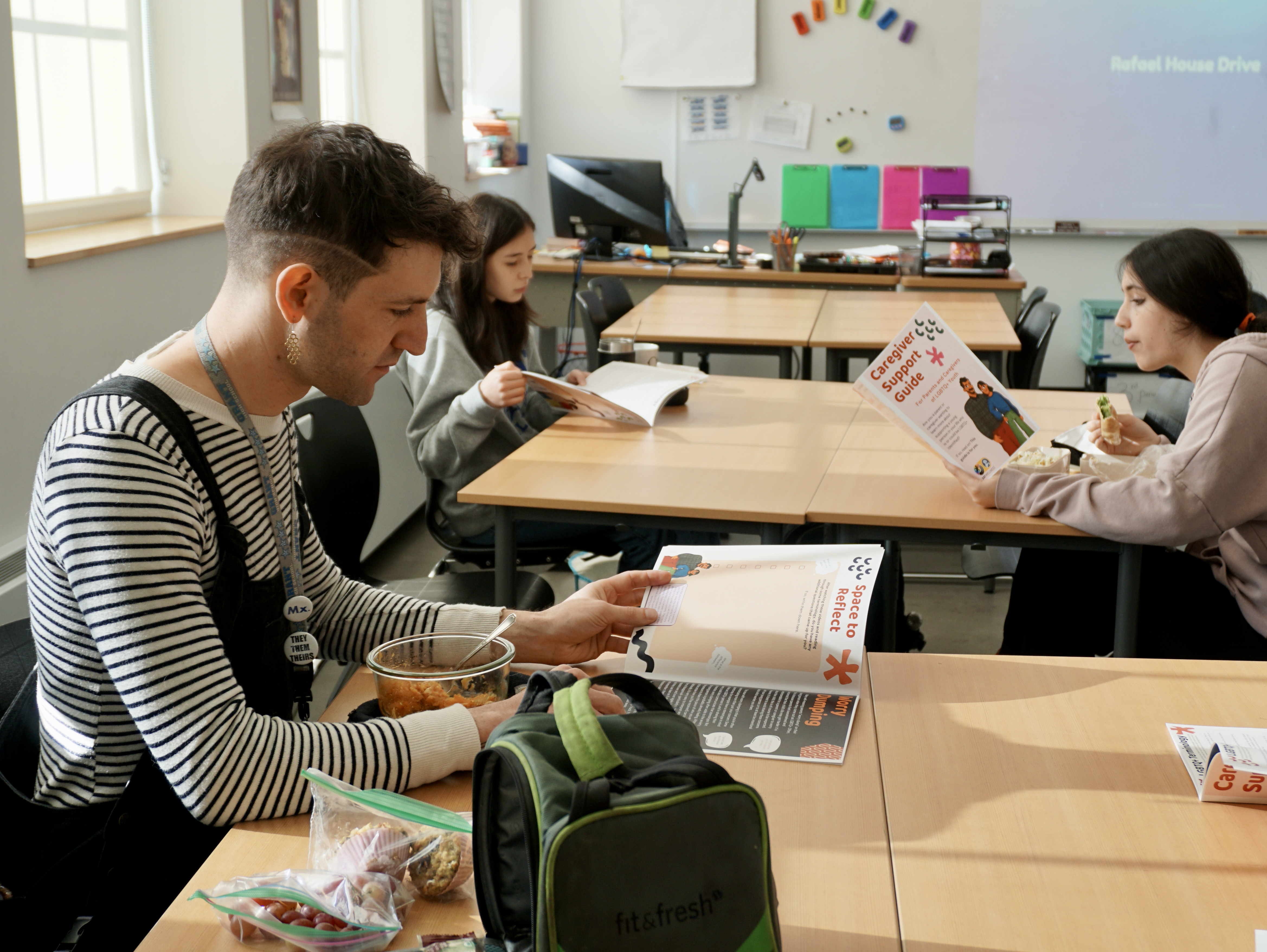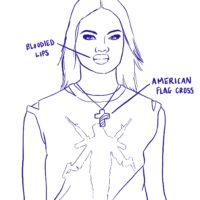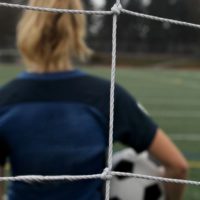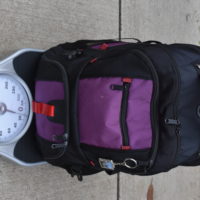
On a summer afternoon two years ago, Chris Lodore walked into a “Wildfang” with a single goal: to find a cute pair of coveralls. They had seen the colorfully patterned coveralls online and hadn’t been able to shake the idea of them since. Marking their calendar with the date they could finally make the trip to the store, Lodore was determined to get to the bottom of the garment’s appeal. At the same time, Lodore tried not to get their hopes up, thinking, “I’m going to find that it probably doesn’t fit because I’m so tall, and I’m going to leave. That’ll be fine, I’ll get that over with.”
When Lodore slipped the coveralls on in the store’s dressing room, everything changed. They fit well and felt comfortable. “It was a huge turning point for me,” says Lodore. They remember stepping out of the dressing room and getting an enthusiastic reaction from their friends, store employees and even other customers who celebrated their expression. The coveralls were a dramatic contrast to their usual attire: jeans and a T-shirt in muted colors.
Their clothing had moved beyond strict functionality. Lodore says, “I wore something just because it was pretty and I liked it,” a new and exciting change. It was the first time Lodore had experimented with their gender identity in a public setting, which set their outward transition into motion.
On the first day of school a couple of months later, Lodore showed up in the purple flower-patterned coveralls, walking the Grant hallways as their authentic self.
Lodore is a freshman physics teacher at Grant High School. During their time at Grant, they’ve explored their gender identity and expression with different names and pronouns. Last year, Lodore came out as nonbinary and started using they/them pronouns.
Lodore grew up in Steamboat Springs, a largely conservative town in Colorado that they say was “definitely not a safe place to be out, even today.”
From a very young age, Lodore has been curious about their gender. As a child, when their neighbor introduced them to the idea of tomboys, Lodore knew they wanted to be one — not even knowing what the label meant. They were met with the kind of dismissive laughter parents give kids who make silly proclamations. Lodore was confused again when they were told they were going to “be a man someday,” not knowing what that entailed either.
No teachers or staff at Lodore’s high school identified as LGBTQ, and there were only two students who identified as gay. Lodore says they were “both fascinated (by) and in fear for (the gay students)” because of the nature of the environment. They add, “It was just a scary place and a scary time.”
Anti-LGBTQ ideas weren’t only spread in the school halls — they permeated Lodore’s home, too. “A lot of the pressures of staying hidden and staying closeted in so many ways came from (my dad),” they say.
The idea of being a science teacher first sprouted in Lodore’s mind when they took AP Biology during their junior year of high school.
After high school, Lodore stayed in-state before transferring to The Evergreen State College in Olympia, Washington where they received their undergraduate degree in environmental studies.
After earning their degree, Lodore still felt as though they needed to gain more life experience and maturity before becoming a teacher. So, they took some time to figure themself out, hoping it would help them become the coolest person they could be — one who did cool things with their future students.
Another factor that made Lodore reluctant to return to a secondary school environment so quickly was their own high school experience. They ended up working miscellaneous seasonal jobs, including one in outdoor education as a trip guide.
Lodore especially enjoyed the work they did at NW Outdoor Science School, a program in Oregon that lets sixth graders travel to a summer camp for a week to learn about the outdoors. “Honestly, the whole time I was doing that work I was like, ‘I can’t believe they pay me for this,’” says Lodore. “Teaching is something I’ve really enjoyed.”
They add, “If I can be part of that “ah-ha” moment, I just love seeing that.”
After bouncing around jobs for awhile, Lodore decided to take a couple years as a stay-at-home parent.
Lodore and their co-parent have decided to push back against gender norms and raise their child as gender-neutral as possible, venturing into both the “boy” and “girl” isles to pick out clothing. They encourage their child to experiment with activities, pronouns and clothing as he wishes, trying not to confine him to any boxes.
Lodore remembers a time that their son was playing at the park in a princess dress. After a while, another parent at the park told his daughter to “say thanks to that little girl for playing with you.” Lodore remembers their child saying, “I’m a boy, don’t I look like a boy?” Lodore recalls how they were proud of their son in that moment saying, “I love that so much, that he was very strong in who he was and that he knew what he liked and he played with what he liked.”
During the last year that Lodore was stay-at-home parenting, they started their teaching program. After completing graduate school, Lodore spent a year as a student teacher at McDaniel High School in Northeast Portland. The next year, they began teaching freshman physics at Grant.
When the COVID-19 pandemic started part way through their first year of teaching, Lodore was left with plenty of spare time to explore the aspects of their gender identity that they previously hadn’t. They explored blogs, clothing, books and spoke with trusted friends and family.
Lodore started going on long walks with transgender friends and talking to other people in their family and profession who had similar experiences. Very quickly, Lodore’s perception of their own gender identity started to dramatically shift. “When it started to crumble, it all went,” they say.
Lodore started attending Grant’s monthly Queer Straight Alliance (QSA) meetings during lockdown. They were impressed by how the students took initiative to run the club.
When in-person learning resumed in September 2021, Lodore decided to start using they/them pronouns with their students. They say a major motivator for making the change early on was not wanting to change pronouns on their students in the middle of the year.
Watching their students’ vibrancy and pride helped them gain confidence with their own identity. “There’s a freshness about the students that I think really helps inspire me to show up more authentically in general, and that’s been really helpful on my journey,” says Lodore.
The students in Lodore’s classes were all adaptable to their pronouns, which gave Lodore confidence in other aspects of their life. “I was like, ‘I’ve got 150 students every day who’ve got my back and my pronouns and my presentation,” says Lodore, “I can walk around downtown Portland or come out to my friends.’”
Now, Lodore uses the honorific “Mx,” introduced to them by a student, and are continuing with they/them pronouns. They hope that they can lead by example at Grant by being comfortable in their own identity. They aim to provide a space where all students — not just LGBTQ-identifying ones — can feel safe. “I hope that for the (students) who are questioning and wondering about themselves that they see some safety in seeing me. That would be really cool.”
Lodore still attends QSA meetings whenever they get the chance. They enjoy chatting in the back with the other advisors and watching students enjoy the affinity space.
Now, Lodore uses fashion as an outlet to explore their gender identity more than ever. They often come to school sporting a colorful outfit, typically thrifted or discovered at a local clothing exchange. Lodore says they’re starting to realize that clothes aren’t just functional — they’re a wonderful tool for self expression.
Lodore wants their students to come out of their class feeling accomplished. “I just want them to feel safe,” they say, “Safe both in themselves to be who they are, and safe to try something hard, and to be pushed in something that maybe they wouldn’t choose if they had the option.”
For Lodore, they just want to create a space to learn and be seen where students and educators alike can thrive as their authentic selves.




